The Iron-Fisted Monk (1977)
Directed by: Sammo Hung
Written by: Feng Huang, Pro Hung Ching
Starring: Hark-On Fung, James Tien, Sammo Hung, Sing Chen
AKA SAN DE HUO SHANG YU CHONG MI LIUS
Hong Kong
AVAILABLE IN THE ‘THREE FILMS WITH SAMMO HUNG’ BOXSET FROM EUREKA ENTERTAINMENT
RUNNING TIME: 97 mins
REVIEWED BY: Dr Lenera, Official HCF Critic
During the time of China’s Qing dynasty when the Manchus cruelly ruled the country, Rice Pounder Six [or Husky Joe or Husker depending on which version of the film you watch] fails to save his uncle from being killed by Manchu thugs, but is himself saved by San-Te, a Shaolin monk. San-Te gets Rice to become a student at the Shaolin Temple, but Rice grows impatient and sneaks away, only to be banished forever from the Temple and beaten up as an extra punishment. When an enraged man, Liang, whose sister has been raped by a Manchu, stabs to death another Manchu beaten up by Rice for bullying some kids, Rice is blamed, and he soon finds out that he he isn’t nearly as polished as San Te in terms of fighting skill….
I should probably begin this review by apologising to Eureka Entertainment for the lateness of this review and the two to follow – all I’ll say is that is that even movie-mad Dr Lenera needs to take a holiday sometimes, and not being aware of the postponing of the release date of Eureka’s Three Films With Sammo Hung boxset, he assumed that he wasn’t going to receive a copy. Now that that’s out of the way, let’s talk for a minute about Sammo Hung, the best known of Jackie Chan’s Peking Opera school childhood buddies though still nowhere near as big a name as Chan outside of the world of Hong Kong movie fandom. I wouldn’t blame Hung if he’s a bit resentful of Chan’s huge success. Though probably not as quite as good a martial artist, I’d go as far to say that Hung is somewhat ahead of Chan as a filmmaker – and if you don’t agree with the latter, I’m sure you’ll agree that he was braver, more ambitious, at least during Hong Kong cinema’s Golden Age. Chan found a formula that worked for him and which people loved, and stuck to it, while Hung tried to do different things – but often with less commercial success – and eventually found himself not headlining films any more, though he’s still worked steadily, especially as a fight choreographer and producer, Eureka have decided to take a further break from Jackie Chan releases [though Chan lovers, don’t worry, 88 Films have some goodies coming out soon] for a bit and instead bring out some highlights from Hung’s resume. Now if you’d asked me what would be the perfect films for a Hung box set, I’d say Eastern Condors, Millionaire’s Express and Pedicab Driver. Eureka only offer Eastern Condors out of those three, but on the other hand the other two are films I’ve never seen before. And the first one The Iron-Fisted Monk turned out to provide me with plentiful old skool chopsocky goodness along with a few surprises. What’s not to like?
Every now and again, I find myself unable to include my usual ‘background information on the making of the film’ paragraph in a review, and this will be the case with the three movies from Eureka’s set as such information is scarce, but I’ll have plenty to say nonetheless. The Iron-Fisted Monk was Hung’s first directorial effort after Shaolin Plot, which he’d starred in, and which was a hit. Hung later said that The Iron-Fisted Monk was the first ‘kung fu comedy’, a subgenre which was soon after popularised by Chan in Snake In The Eagle’s Shadow and the Chan box office stormers to follow, though with all due respect I’d dispute Hung’s claim, because The Spiritual Boxer had come out two years before. It certainly begins in a light vain, with his prank pulling, cheeky character very similar to the one Chan was about to play and then provide variations on throughout much of his career. But soon after that, things get very serious, and the tone of the early scenes is never entirely regained, even though there are still a few laughs to be had. If you select the ‘classic English dub’ when you play the Blu-ray [which if you’re familiar with my reviews you’ll know is my preferred soundtrack option for these early films, hell, it’s part of the experience!], you’ll have the words “Buddha be praised” ringing in your head for days after. Those words are uttered constantly by the ‘iron fisted monk’ of the title, though who he actually is probably leads to confusion at times. While this film certainly has Hung’s character as the chief protagonist, he’s not the title person. That is his companion in eventual revenge taking, Shaolin monk San-Te – and it took me 20 minutes to realise that this was an older version of the same real life character who was the hero of The 36th Chamber Of Shaolin, one of the all-time masterpieces of the genre. I mean how bloody cool is this film? Hung’s character was also real.
We first find – well, lets call him Husky Joe as per the ‘classic’ dub – undergoing a training brawl with Casanova Wong, and if you’ve never seen Hung in action then his flips will truly amaze. James Tien plays the un-named monk who Joe aspires to be, and I was expecting him to turn out to be a bad guy as is the norm with films with him in. Joe busies himself with labour-saving devices, but is impatient despite being nowhere a good enough fighter to take on the Manchus. A flashback shows Joe intervening in an inn where his uncle is being beaten up, and San-Te saving him. Joe runs away, but Tien catches up with him and defeats him in an amusing scene where four monks name different fighting techniques and Tien has to use each one against Joe to punish him. But then things suddenly change as we switch to the villainous – well, he’s just called ‘official’ and played by familiar bad guy Fung Hak-On – raping a woman while his slimy aide [just called ‘Manchu’ but played by another common villain Dean Shek] watches in a scene originally cut by over a minute in the UK. Now I’m sure that anyone who regularly reads a website called ‘Horror Cult Films’ will have seen more graphic scenes of a similar nature, but martial arts films rarely went this far, and I can see many finding the scene out of place. It’s unpleasant to watch, but I do admire the bravery of Hung and his co-screenwriters Huang Feng and Yu Ting here. Immediately after this, a secondary bad guy goes and bullies a bunch of kids, cutting off their braids [it was illegal not to have a ponytail at the time], knocking the poor lads to the ground, and being about to slit the throat of one until interrupted by Joe in the nick of time. These aren’t cool villains or bad guys you laugh at [well, except for one unintentionally hilarious moment where a major plot element is revealed to Joe when he passes by one villain laughing in a sinister fashion to himself and thereby giving himself away], these are reprehensible scum you just can’t wait to see punished.
However, San-Te is usually on hand to warn against hastiness, even when he, Joe, and Liang, the brother of the woman who we see raped and then killing herself, form a kind of team. The sense of threat is definitely strong and is maintained due to us having witnessed the nastiness of these brutes, but as is sometimes the case with these films, the pace slackens just a bit around two thirds of the way through and a subplot involving a factory which the Manchus are trying to take over is introduced which fails to really add anything. A related plot twist will strike some as being too cruel, though as I get older it’s the kind of surprise that I like. In any case, this is all forgiven by the stunning climactic fighting, unusually for the time taking place mostly indoors instead of the usual outside locales [often the same hill just outside Hong Kong]. We’ve already seen sights such as a sword wielding Joe battling Tien with a staff, a mass battle with weapons like a meteor hammer [ball and chain] being put to graphic use, and a confrontation in a brothel [Hung did like brothels in his films] which begins in comedic vain with Joe accepting humiliation rather too easily and the villains then ending up with their trousers falling down and their purses missing before things continue more violently. But now our heroes go toe to toe with the main bad guys in awesome fashion. Throughout, you can see the seeds of Hung’s action filming which would soon become second to none, even Chan’s work, for a while. The traditional ‘just plonk the camera down in one place’ style is partly retained through long takes, but the camera is often more mobile, sometimes tracking from one fight to another, and at times the editing is faster.
The choreography combines the staunch, intricate precision of the work of Lau Kar-Leung [the great Shaw Brothers choreographer who went on to direct the likes of The 36th Chamber Of Shaolin and Legendary Weapons Of China] with the playfulness of Snake in the Eagle’s Shadow and Drunken Master – but nearly half a year before the first of the latter films was released! While some rapid shifts in tone are sometimes jarring, you can see that Hung was already trying to do a few unexpected things with a very basic and well worn formula. The construction of the plot feels a bit rushed, but this is certainly not one of those efforts where you’re just sitting there twiddling your thumbs between the fight scenes. Instead, you’ll probably care. While I can see some finding a jokey moment in the brothel involving topless nudity to be unnecessary [I can’t say it bothered me, but then I’m still happy to admit that even in this day and age I don’t find the sight of a pair of breasts to be something bad], the only real complaint that I have, aside from Hung’s performance which is resolutely comical throughout and thereby sometimes appears to exist in a different film to the one that we’re watching, is that we don’t get a full-on training sequence. For me, such scenes are often my personal highlights in these films, and it also means that Joe seems to suddenly become a very skillful fighter very suddenly. But then Hung and co. probably intended to subvert expectations here. And they did deliver a reasonably good looking piece. Some of the usual clumsy camera zooms and the like are on offer, but there are hints of a more technically sophisticated offering, such as a split screen flashback showing us a part of a scene that we didn’t see earlier, and an elegant high angle shot of the main reception room of the brothel with the camera moving gracefully and us being able to take in the detail and the ambience of the place. And none of the music seems familiar, though the humorous main theme doesn’t always feel appropriate.
Some ambiguity is attempted at times. For example, San-Te, well played by Wong Hong, who also wrote the screenplay and was Hung’s mentor for several years before, preaches restraint and patience, and for much of the time he’s the coolest character in the film, the one you just want to be, a monk clearly at peace with himself but happy to break rules so he can enjoy himself at times. And yet said restraint and patience ends up causing more tragedy. I’m not claiming too much depth for this film, and some may laugh, but then if you think martial arts films aren’t worth much then you probably wouldn’t be reading this review anyway. I do think that quite a bit of thought was put into making The Iron-Fisted Monk a good, solid film, even if maybe a few of the pieces don’t quite fit – though I can’t say that bothered me too much. After all, one of the things that got many of us into Hong Kong movies back in the day was the way many of them would seem to change tone and even genre – several times. Saying that, seen today, The Iron-Fisted Monk should probably not be a first choice for somebody new to these films, but for the reasonably seasoned martial arts movie watcher it will offer much of what you want, plus a small number of things you may not expect. Overall the first film in Eureka’s set is a winner in my book. Let’s hope that films number two and three [well, it’s been ages since I’ve seen Eastern Condors] are equally worthy.
Rating: 









This continues the current trend of Eureka Hong Kong Blu-ray releases that just look stunning. The red writing during the opening credits ‘bleeds’ a little, but don’t let put you off, everything from thereon is quite marvelous, with what looks like accurate colour grading and great detail. None of the old L’Immagine Ritrovata flaws here to my eyes. Panning shots sometimes show soft edges of the frame, though this is probably due to print deterioration.I began watching the film with the Cantonese dub. But, me being me, I soon switched over to the ‘classic dub’, with occasional switches back to compare some translations. There are many differences, such as “I’ll rip off your hands” becoming “I’ll break your neck”, and the Manchus often referred to as the “Bannermen” in the subtitles. Occasionally the subtitles are more interesting, such as “I hope your son’s born with two arses” being replaced with something that’s not even an insult in the English dub. I’m sure that the newly translated subtitles are accurate, but I just find these ‘classi’c dubs to be preferable. Yeah, I’m a heathen. A few years later they began to be blander and lacking in much character, which is why for something such as Police Story I prefer to watch it in Cantonese. I’m so grateful to Eureka for going the extra mile to find and include such dubs. We could have been left with just the more recent English dub of this film to ‘enjoy’. Put the latter on for a few minutes, you’ll appreciate the older dub more despite the technical aspects being undoubtedly better. All audio options are mono, which was perfectly fine on my simple set-up.
Seeing as that great team of Mike Leeder and Arne Venema do audio commentaries on the other two films, I was a tad disappointed that somebody else does the one for The Iron-Fisted Monk, but Frank Djein provides an excellent track full of knowledge and observation. He clearly admires the film but feels that the sexual content is out of place [well, maybe we didn’t need to see the beginnings of a second rape!]. We learn that the inspiration for the film was a comic book, when the voice actor who did Chan for many years can be heard, and when different fighting styles are on screen. Djeng is very calm and measured, and the gaps do increase, but you won’t be bored, and may even cheer when he says how he’s not bothering with biographies as you can easily find those on the internet. I wish other commentators would do the same. This is followed by two interviews with Hung, one of which is taken from the Hong Kong Legends DVD and the other – I’m not sure about, though it could also be a Hong Kong Legends one judging by the music and graphics. Both are short, and the same information is covered too, Hung talking about the project’s origins and how smooth the filming. The first does go in a bit more detail on Hung’s relationship with Hong and how he was fine doing three or more tasks on a film. Not hugely revelatory are these, but nice to have anyway.
THREE FILMS WITH SAMMO HUNG BOXSET SPECIAL FEATURES
*Includes O-Card slipcase
*Stunning 1080p presentation of all three films on Blu-ray, from brand new 2K restorations and in their original widescreen aspect ratios
*Original Cantonese mono tracks for all three films
*English audio options, all three films include the option of “classic” English dubs from the films original international releases, and the newer English dubs produced for later home video releases
THE IRON-FISTED MONK
*New audio commentary by Asian film expert Frank Djeng
*Interview with Sammo Hung [13 mins]
*Interview with Sammo Hung [5 mins]
*Trailer

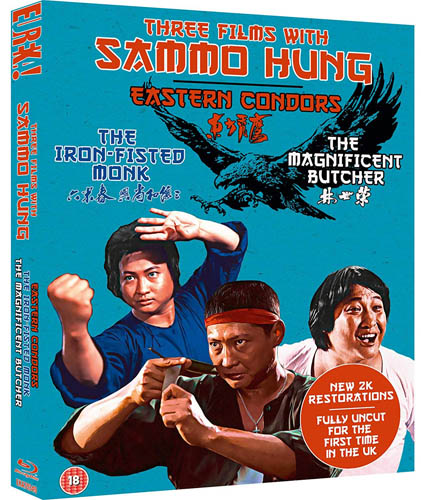
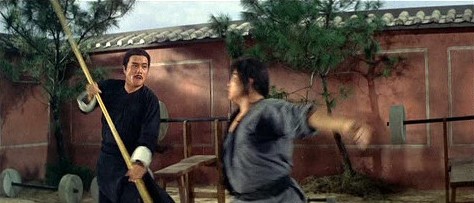
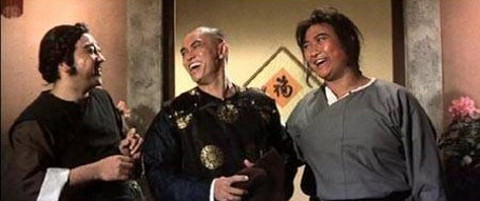


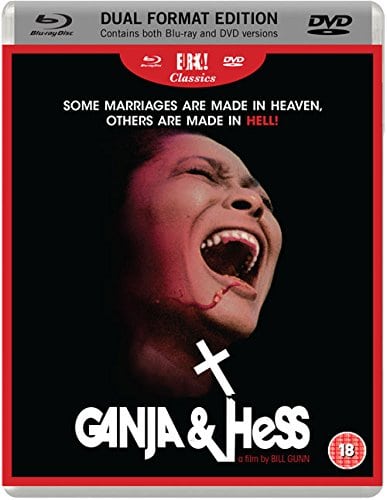
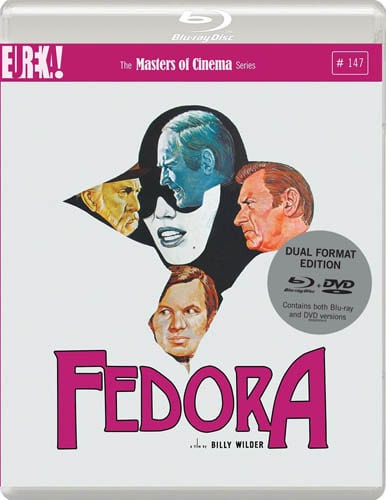
Be the first to comment